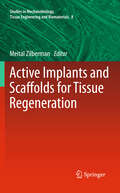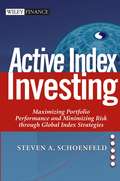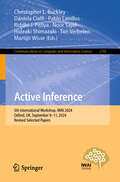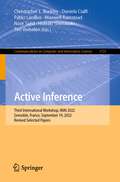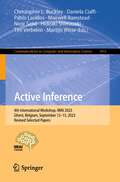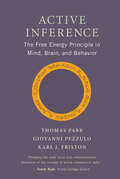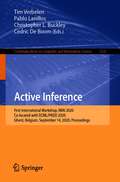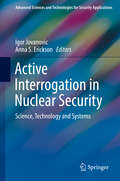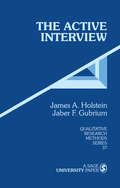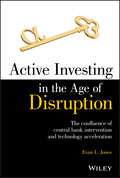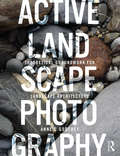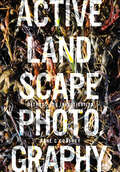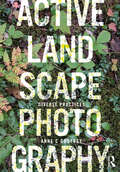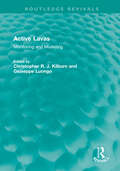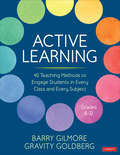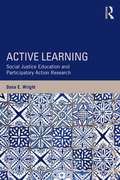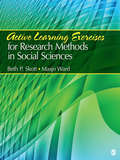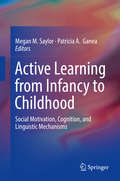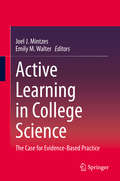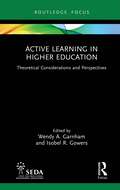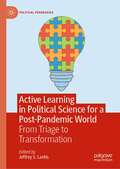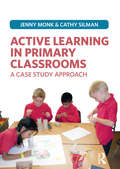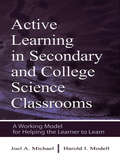- Table View
- List View
Active Implants and Scaffolds for Tissue Regeneration (Studies in Mechanobiology, Tissue Engineering and Biomaterials #8)
by Meital ZilbermanActive implants are actually drug or protein-eluting implants that induce healing effects, in addition to their regular task, such as support. This effect is achieved by controlled release of the active agent to the surrounding tissue. This book will give a broad overview of biomaterial platforms used as basic elements of drug-eluting implants. It will include mainly coatings for vascular stents with controlled release of antiproliferative agents, wound dressings with controlled release of antibacterial agents, drug-eluting vascular grafts, protein-eluting scaffolds for tissue regeneration, drug-eluting platforms for dental and other applications. Thus, both internal and external implants are described. The drug-eluting implants will be described in terms of matrix formats and polymers, incorporated drugs and their release profiles from the implants, as well as implant functioning. Smart polymeric systems, such as crosslinked poly-lactones, thermo and pH-sensitive hydrogels and poly(amido-amines), as well as novel basic structural elements, such as composite fibers and films, and nanostructures will be thoroughly described. The effect of the processing parameters on the microstructure and on the resulting drug release profiles, mechanical and physical properties, and other relevant properties, will be emphasized. The described new biomaterials approaches for active implants enhance the tools available for creating clinically important biomedical applications.
Active Index Investing
by Steven A. SchoenfeldFor over three decades, indexing has become increasingly accepted by both institutional and individual investors. Index benchmarks and investment products that track them have been a driving force in the transformation of investment strategy from art to science. Yet investors' understanding of the sophistication of this burgeoning field has lagged the growing use of index products.Active Index Investing is the definitive guide to how indexes are constructed, how index-based portfolios are managed, and how the world's most sophisticated investors use index-based strategies to enhance performance, reduce costs and minimize the risks of investing.Active Index Investing provides a comprehensive overview of (1) the investment theories that are the foundation of index based investing, (2) best practices in benchmark construction, (3) the growing world of index-based investment vehicles, (4) cutting-edge index portfolio management techniq ues and (5) the myriad ways investors can and do capture the benefits of indexing.Active Index Investing has a unique format that captures the views and perspectives of over 40 of the investment industry's leading experts and practitioners, while maintaining a holistic view of this complex subject matter. In addition to the Appendix and Glossary within the book, it features an E-ppendix, available at www.IndexUniverse.com
Active Inference: 5th International Workshop, IWAI 2024, Oxford, UK, September 9–11, 2024, Revised Selected Papers (Communications in Computer and Information Science #2193)
by Christopher L. Buckley Daniela Cialfi Pablo Lanillos Riddhi J. Pitliya Noor Sajid Hideaki Shimazaki Tim Verbelen Martijn WisseThis book constitutes the revised selected papers of the 5th International Workshop on Active Inference, IWAI 2024, held in Oxford, UK, during September 9–11, 2024. The 17 full papers included in this book were carefully reviewed and selected from 54 submissions. They were organized in topical sections as follows: Modeling Behaviour and Emotions; Hybrid Continuous-discrete Systems; Structure Learning; Multi-agent Systems; Epistemic Sampling; Robot Control; and Sustainability and Contextuality.
Active Inference: Third International Workshop, IWAI 2022, Grenoble, France, September 19, 2022, Revised Selected Papers (Communications in Computer and Information Science #1721)
by Christopher L. Buckley Daniela Cialfi Pablo Lanillos Maxwell Ramstead Noor Sajid Hideaki Shimazaki Tim VerbelenThis volume constitutes the papers of the 3rd International Workshop on Active Inference, IWAI 2022, held in Grenoble, France, in conjunction with ECML/PKDD, on September 19, 2022.The 25 revised full papers presented in this book were carefully reviewed and selected from 31 submissions.
Active Inference: 4th International Workshop, IWAI 2023, Ghent, Belgium, September 13–15, 2023, Revised Selected Papers (Communications in Computer and Information Science #1915)
by Christopher L. Buckley Daniela Cialfi Pablo Lanillos Maxwell Ramstead Noor Sajid Hideaki Shimazaki Tim Verbelen Martijn WisseThis volume constitutes the papers of the 4th International Workshop on Active Inference, IWAI 2023, held in Ghent, Belgium on September 2023.The 17 full papers included in this book were carefully reviewed and selected from 34 submissions. They were organized in topical sections as follows: active inference and robotics; decision-making and control; active inference and psychology; from theory to implementation; learning representations for active inference; and theory of learning and inference.
Active Inference: The Free Energy Principle in Mind, Brain, and Behavior
by Thomas Parr Karl J. Friston Giovanni PezzuloThe first comprehensive treatment of active inference, an integrative perspective on brain, cognition, and behavior used across multiple disciplines. Active inference is a way of understanding sentient behavior—a theory that characterizes perception, planning, and action in terms of probabilistic inference. Developed by theoretical neuroscientist Karl Friston over years of groundbreaking research, active inference provides an integrated perspective on brain, cognition, and behavior that is increasingly used across multiple disciplines including neuroscience, psychology, and philosophy. Active inference puts the action into perception. This book offers the first comprehensive treatment of active inference, covering theory, applications, and cognitive domains. Active inference is a &“first principles&” approach to understanding behavior and the brain, framed in terms of a single imperative to minimize free energy. The book emphasizes the implications of the free energy principle for understanding how the brain works. It first introduces active inference both conceptually and formally, contextualizing it within current theories of cognition. It then provides specific examples of computational models that use active inference to explain such cognitive phenomena as perception, attention, memory, and planning.
Active Inference: First International Workshop, IWAI 2020, Co-located with ECML/PKDD 2020, Ghent, Belgium, September 14, 2020, Proceedings (Communications in Computer and Information Science #1326)
by Tim Verbelen Pablo Lanillos Christopher L. Buckley Cedric De BoomThis book constitutes the refereed proceedings of the First International Workshop on Active Inference, IWAI 2020, co-located with ECML/PKDD 2020, held in Ghent, Belgium, in September 2020. The 13 full papers along with 6 short papers were thoroughly reviewed and selected from 25 submissions. They are organized in the topical sections on active inference and continuous control; active inference and machine learning; active inference: theory and biology.
Active Interrogation in Nuclear Security: Science, Technology and Systems (Advanced Sciences and Technologies for Security Applications)
by Igor Jovanovic Anna S. EricksonThis volume constitutes the state-of-the-art in active interrogation, widely recognized as indispensable methods for addressing current and future nuclear security needs. Written by a leading group of science and technology experts, this comprehensive reference presents technologies and systems in the context of the fundamental physics challenges and practical requirements. It compares the features, limitations, technologies, and impact of passive and active measurement techniques; describes radiation sources for active interrogation including electron and ion accelerators, intense lasers, and radioisotope-based sources; and it describes radiation detectors used for active interrogation. Entire chapters are devoted to data acquisition and processing systems, modeling and simulation, data interpretation and algorithms, and a survey of working active measurement systems. Active Interrogation in Nuclear Security is structured to appeal to a range of audiences, including graduate students, active researchers in the field, and policy analysts.The first book devoted entirely to active interrogationPresents a focused review of the relevant physicsSurveys available technologyAnalyzes scientific and technology trends Provides historical and policy context Igor Jovanovic is a Professor of Nuclear Engineering and Radiological Sciences at the University of Michigan and has previously also taught at Penn State University and Purdue University. He received his Ph.D. from University of California, Berkeley and worked as physicist at Lawrence Livermore National Laboratory. Dr. Jovanovic has made numerous contributions to the science and technology of radiation detection, as well as the radiation sources for use in active interrogation in nuclear security. He has taught numerous undergraduate and graduate courses in areas that include radiation detection, nuclear physics, and nuclear security. At University of Michigan Dr. Jovanovic is the director of Neutron Science Laboratory and is also associated with the Center for Ultrafast Optical Science. Anna Erickson is an Assistant Professor in the Nuclear and Radiological Engineering Program of the G.W. Woodruff School of Mechanical Engineering at Georgia Institute of Technology. Previously, she was a postdoctoral researcher in the Advanced Detectors Group at Lawrence Livermore National Laboratory. Dr. Erickson received her PhD from Massachusetts Institute of Technology with a focus on radiation detection for active interrogation applications. Her research interests focus on nuclear non-proliferation including antineutrino analysis and non-traditional detector design and characterization. She teaches courses in advanced experimental detection for reactor and nuclear nonproliferation applications, radiation dosimetry and fast reactor analysis.
The Active Interview
by Jaber F. Gubrium Dr James A. HolsteinInterviews were once regarded as the pipeline through which information was transmitted from a passive subject to an omniscient researcher. However the new "active interview" considers interviewers and interviewees as equal partners in constructing meaning around an interview. This interpretation changes a range of elements in the interview process - from the way of conceiving a sample to the ways in which the interview may be conducted and the results analyzed. In this guide, the authors outline the differences between active and traditional interviews and give novice researchers clear guidelines on conducting a successful interview.
Active Investing: How to Manage Your Portfolio Like a Professional in Less than One Hour a Week
by Alan HullWhy pay a financial adviser to manage your portfolio when you can do it yourself -- all in less than one hour a week? The first edition of Active Investing was an Australian bestseller and a must-have for all DIY share investors and traders. In this book, sharemarket expert Alan Hull provides all types of investors with simple but effective methods for keeping one step ahead of the market using low-risk, tried-and-tested techniques. Fully revised and updated due to popular demand, this new edition will show you how to profit in all sharemarket conditions. You’ll discover: when to buy shares, when to hold them and when to keep your money in the bank how to survive volatility and even profit in a falling market how to sensibly use CFDs and protect your portfolio from market risk. Manage your portfolio like a professional -- become an active investor!
Active Investing in the Age of Disruption
by Evan L. JonesOutperforming the market—or “alpha creation” as it’s sometimes called—is very possible with the proper investment discipline and methodologies. But the market-beating strategies that will work today are not the same as those that worked in the past. Central bank intervention and the accelerated pace of technology have caused an increase in the disruption of traditional business models across many industries. These industry paradigm shifts combined with macro-driven financial markets have created one of the toughest environments for active investment managers in history. Active Investing in the Age of Disruption details the disruptive forces in the market today and how to navigate them to outperform. This book discusses winning equity investment strategies with lofty goals of alpha creation. Understanding the limits and potential of each unique investment methodology and portfolio strategy will allow you to generate higher returns. Even when your luck runs out or the market works against you, the ideas and disciplined approach in this book will keep you one step ahead of the market. · Understand the disruptive forces affecting the market today · Discover equity investment strategies uniquely targeting alpha generation—beating the market · Understand which features of active investing need to be implemented and stressed from a risk perspective to outperform the market · Learn which previously solid investment tenets may no longer hold true in the age of market disruption · Hone the craft of active investing—identify markets with the greatest profit potential, hedge against strategy limitations, and more It has been a very tough decade for active investment managers, but this book will inspire you to think differently about risks and opportunity. A deeper understanding of the forces affecting the market and a commitment to refining your investment process using the techniques in this book will help you step across the margin of error between under and outperforming.
Active Landscape Photography: Theoretical Groundwork for Landscape Architecture
by Anne C GodfreyPhotographs play a hugely influential but largely unexamined role in the practice of landscape architecture and design. Through a diverse set of essays and case studies, this seminal text unpacks the complex relationship between landscape architecture and photography. It explores the influence of photographic seeing on the design process by presenting theoretical concepts from photography and cultural theory through the lens of landscape architecture practice to create a rigorous, open discussion. Beautifully illustrated in full color throughout, with over 200 images, subjects covered include the diversity of everyday photographic practices for design decision making, the perception of landscape architecture through photography, transcending the objective and subjective with photography, and deploying multiplicity in photographic representation as a means to better represent the complexity of the discipline. Rather than solving problems and providing tidy solutions to the ubiquitous relationship between photography and landscape architecture, this book aims to invigorate a wider dialogue about photography's influence on how landscapes are understood, valued and designed. Active photographic practices are presented throughout for professionals, academics, students and researchers.
Active Landscape Photography: Methods for Investigation (Active Landscape Photography)
by Anne C GodfreyHow can photography be transformed into an active process of investigation for landscape architecture and environmental design? The second book in Godfrey’s series, Active Landscape Photography, presents engaged photographic methods that turn photography into a rigorous, thoughtful endeavor for the research, planning and design of landscape places. Photography is the most ubiquitous and important form of representation in these disciplines. Yet photography is not specifically taught as a core skill within these fields. This book creates a starting point for filling this gap. Concepts and working methods from contemporary photography and critical cultural theories are contextualized into situations encountered in the daily practice of landscape architecture and environmental design. These methods can be integrated into practices in academic and professional settings or picked up and self-taught by an individual reader. Part I: Methods presents easily accessible approaches to photography creating a core set of active skills. Part II: Practices discusses working methods of specific contemporary photographers and extrapolates their practices into common extrapolates their practices into common planning and design situations. Contemporary photographers presented include Richard Misrach, Dawoud Bey, Duane Michals, Latoya Ruby Frazier, Mark Klett, Sophie Calle, Joe Deal, Robert Adams, Naima Green, Bernd and Hilla Becher, Stephen Shore, David Hockney, Amy Sherald, William Christenberry, Jeff Wall, and Sohei Nishino. Beautifully illustrated in full color with over 150 images by Godfrey, her students, and contemporary photographers, this book provides both clear guidelines for a set of diverse methods as well as a deeper discussion about the implications of making and using photography in environmental design for professionals, academics, students and researchers.
Active Landscape Photography: Diverse Practices (Active Landscape Photography)
by Anne C GodfreyDiverse Practices, the third book in the Active Landscape Photography series, presents a set of unique photographic examples for site-specific investigations of landscape places. Contributed by authors across academia, practice and photography, each chapter serves as a rigorous discussion about photographic methods for the landscape and their underlying concepts. Chapters also serve as unique case studies about specific projects, places and landscape issues. Project sites include the Miller Garden, Olana, XX Miller Prize and the Philando Castile Peace Garden. Landscape places discussed include the archeological landscapes of North Peru, watery littoral zones, the remote White Pass in Alaska, Sau Paulo and New York City’s Chinatown. Photographic image-making approaches include the use of lidar, repeat photography, collage, mapping, remote image capture, portraiture, image mining of internet sources, visual impact assessment, cameraless photography, transect walking and interviewing. These diverse practices demonstrate how photography, when utilized through a set of specific critical methods, becomes a rich process for investigating the landscape. Exploring this concept in relationship to specific contemporary sties and landscape issues reveals the intricacy and subtlety that exists when photography is used actively. Practitioners, academics, students and researchers will be inspired by the underlying concepts of these examples and come away with a better understanding about how to create their own rigorous photographic practices.
Active Lavas: Monitoring and Modelling (Routledge Revivals)
by Christopher R.J. Kilburn Giuseppe LuongoOriginally published in 1993, Active Lavas looks at the practical aspects of monitoring uncontrolled streams of molten rock and how field data can be applied for theoretical modelling and forecasting the growth of lava flows. It describes the basic features of common subaerial lava flows and domes – both on Earth and on other bodies in the Solar System – before discussing the logistics of measuring lava properties during eruption and how these measurements are used to develop simple theoretical models for forecasting flow behaviour.
Active Learning: 40 Teaching Methods to Engage Students in Every Class and Every Subject, Grades 6-12 (Corwin Teaching Essentials)
by Barry Gilmore Gravity GoldbergTried and true teaching strategies to boost student engagement. Students need to be actively engaged to learn—intellectually curious, physically active, and emotionally involved in collaborative work that builds their capacity for empathy. What can teachers do to instill these elements in the classroom? Active Learning: 40 Teaching Methods To Engage Students In Every Class and Every Subject is the actionable tool every new and veteran teacher needs to construct dynamic learning experiences for students. This hands-on, easy-to-use guide features 40 carefully curated, high-impact teaching strategies that target learning tools, collaboration structures, reading and writing routines, assessment opportunities and more. It includes: Step-by-step teaching strategies that can be mastered quickly and implemented in any order Tools to help teachers identify the most pressing classroom needs and determine which methods to try first Nine instructional structures including essential questions, strategy groups, stations, and simulations Real-world examples, tips, templates, and other supportive resources that offer guidance for each method, identify common challenges, and detail next steps Whether tweaking your existing strategies or finding new moves that will quickly become your own, this is your go-to guide for designing active, engaging learning experiences for students.
Active Learning: 40 Teaching Methods to Engage Students in Every Class and Every Subject, Grades 6-12 (Corwin Teaching Essentials)
by Barry Gilmore Gravity GoldbergTried and true teaching strategies to boost student engagement. Students need to be actively engaged to learn—intellectually curious, physically active, and emotionally involved in collaborative work that builds their capacity for empathy. What can teachers do to instill these elements in the classroom? Active Learning: 40 Teaching Methods To Engage Students In Every Class and Every Subject is the actionable tool every new and veteran teacher needs to construct dynamic learning experiences for students. This hands-on, easy-to-use guide features 40 carefully curated, high-impact teaching strategies that target learning tools, collaboration structures, reading and writing routines, assessment opportunities and more. It includes: Step-by-step teaching strategies that can be mastered quickly and implemented in any order Tools to help teachers identify the most pressing classroom needs and determine which methods to try first Nine instructional structures including essential questions, strategy groups, stations, and simulations Real-world examples, tips, templates, and other supportive resources that offer guidance for each method, identify common challenges, and detail next steps Whether tweaking your existing strategies or finding new moves that will quickly become your own, this is your go-to guide for designing active, engaging learning experiences for students.
Active Learning: Social Justice Education and Participatory Action Research (Teaching/Learning Social Justice)
by Dana E. WrightWhile many educators acknowledge the challenges of a curriculum shaped by test preparation, implementing meaningful new teaching strategies can be difficult. Active Learning presents an examination of innovative, interactive teaching strategies that were successful in engaging urban students who struggled with classroom learning. Drawing on rich ethnographic data, the book proposes participatory action research as a viable approach to teaching and learning that supports the development of multiple literacies in writing, reading, research and oral communication. As Wright argues, in connecting learning to authentic purposes and real world consequences, participatory action research can serve as a model for meaningful urban school reform. After an introduction to the history and demographics of the working-class West Coast neighborhood in which the described PAR project took place, the book discusses the "pedagogy of praxis" method and the project’s successful development of student voice, sociopolitical analysis capacities, leadership skills, empowerment and agency. Topics addressed include an analysis and discussion of the youth-driven PAR process, the reactions of student researchers, and the challenges for adults in maintaining youth and adult partnerships. A thought-provoking response to current educational challenges, Active Learning offers both timely implications for educational reform and recommendations to improve school policies and practices.
Active Learning Exercises for Research Methods in Social Sciences
by Dr Beth P. Skott Masjo H. WardBased on the premise that when students do something instead of simply reading about it, they understand it better, this book is composed of 29 hands-on, active learning activities for use in research methods courses in the social sciences. Research Methods can be a daunting class for students and Beth P. Skott's and Masjo Ward's book is designed to help alleviate that stress and help them become active learners.The activities in Active Learning Exercises for Research Methods in Social Sciences were created by instructors throughout the country and demonstrated to be effective in their classrooms. A variety of activities is included: group activities, solo activities, some that take a lot of time and others that take less time. Each one of them is directly related to a concept of research methods and aims to help students become better researchers.
Active Learning from Infancy to Childhood: Social Motivation, Cognition, And Linguistic Mechanisms
by Patricia A. Ganea Megan M. SaylorThis book presents new findings on the role of active learning in infants’ and young children’s cognitive and linguistic development.<P><P> Chapters discuss evidence-based models, identify possible neurological mechanisms supporting active learning, pinpoint children’s early understanding of learning, and trace children’s recognition of their own learning. Chapters also address how children shape their lexicon, covering a range of active learning practices including interactions with parents, teachers, and peers; curiosity and exploration during play; seeking information from other people and their surroundings; and asking questions. In addition, processes of selective learning are discussed, from learning new words and trusting others in acquiring information to weighing evidence and accepting ambiguity. <P> Topics featured in this book include: Infants’ active role in language learning; The process of active word learning; Understanding when and how explanation promotes exploration; How conversations with parents can affect children’s word associations; Evidence evaluation for active learning and teaching in early childhood; Bilingual children and their role as language brokers for their parents. <P>Active Learning from Infancy to Childhood is a must-have resource for researchers, clinicians and related professionals, and graduate students in developmental psychology, psycholinguistics, educational psychology, and early childhood education.
Active Learning in College Science: The Case for Evidence-Based Practice
by Joel J. Mintzes Emily M. WalterThis book explores evidence-based practice in college science teaching. It is grounded in disciplinary education research by practicing scientists who have chosen to take Wieman’s (2014) challenge seriously, and to investigate claims about the efficacy of alternative strategies in college science teaching. In editing this book, we have chosen to showcase outstanding cases of exemplary practice supported by solid evidence, and to include practitioners who offer models of teaching and learning that meet the high standards of the scientific disciplines. Our intention is to let these distinguished scientists speak for themselves and to offer authentic guidance to those who seek models of excellence. Our primary audience consists of the thousands of dedicated faculty and graduate students who teach undergraduate science at community and technical colleges, 4-year liberal arts institutions, comprehensive regional campuses, and flagship research universities. In keeping with Wieman’s challenge, our primary focus has been on identifying classroom practices that encourage and support meaningful learning and conceptual understanding in the natural sciences. The content is structured as follows: after an Introduction based on Constructivist Learning Theory (Section I), the practices we explore are Eliciting Ideas and Encouraging Reflection (Section II); Using Clickers to Engage Students (Section III); Supporting Peer Interaction through Small Group Activities (Section IV); Restructuring Curriculum and Instruction (Section V); Rethinking the Physical Environment (Section VI); Enhancing Understanding with Technology (Section VII), and Assessing Understanding (Section VIII). The book’s final section (IX) is devoted to Professional Issues facing college and university faculty who choose to adopt active learning in their courses. The common feature underlying all of the strategies described in this book is their emphasis on actively engaging students who seek to make sense of natural objects and events. Many of the strategies we highlight emerge from a constructivist view of learning that has gained widespread acceptance in recent years. In this view, learners make sense of the world by forging connections between new ideas and those that are part of their existing knowledge base. For most students, that knowledge base is riddled with a host of naïve notions, misconceptions and alternative conceptions they have acquired throughout their lives. To a considerable extent, the job of the teacher is to coax out these ideas; to help students understand how their ideas differ from the scientifically accepted view; to assist as students restructure and reconcile their newly acquired knowledge; and to provide opportunities for students to evaluate what they have learned and apply it in novel circumstances. Clearly, this prescription demands far more than most college and university scientists have been prepared for.
Active Learning in Higher Education: Theoretical Considerations and Perspectives (SEDA Focus)
by Wendy A. GarnhamThis insightful new book explores perspectives on active learning as creative discovery, conceptualisations of active learning spaces and transitions from theoretical approaches to active learning practice. It draws on the experiences of academics, learning technologists and clinical practitioners, and invites the reader to think about our conceptualisations of active learning and to move beyond mere demonstrations of its effectiveness. With contributions from academics and NHS practitioners, this publication will make a unique contribution to the literature that increasingly points to the value, impact and reach of active learning pedagogy. It importantly addresses the need for active learning, highlighting some of the many theoretical issues that active learning raises through three broad lenses:- The idea of active learning as creative play- The use of theoretical models in designing active learning- The transition from active learning theory to practiceAimed at anyone with an interest in active learning as a pedagogical approach, Active Learning in Higher Education provides a starting point for further discussion and development of pedagogical theory, becoming an essential read for educators, school leaders as well as researchers in the field of education.
Active Learning in Political Science for a Post-Pandemic World: From Triage to Transformation (Political Pedagogies)
by Jeffrey S. LantisThis book features valuable conversations about how COVID-19 has changed how we teach and even who we are as instructors in political science. This project devotes special attention to how our pedagogy in political science has evolved from ‘triage’ to transformation over the course of the pandemic. This book, part of the Palgrave Macmillan Political Pedagogies series, presents a variety of innovations in political science teaching (from “ungrading” to the flipped classroom) and offers systematic reflections on how our approaches to teaching and learning have been forever changed.
Active Learning in Primary Classrooms: A Case Study Approach
by Jenny Monk Catherine SilmanWhat do they mean by Active Learning? How can you inspire children to engage fully in their learning? How can you plan and organise a curriculum that ensures that children are actively involved in the learning process?This brand new text not only explores and examines the concept of active learning, but demonstrates how every teacher, new or experienced, can translate theory into practice and reap the rewards of children actively engaged in their own learning in the classroom. Central to the book is the series of extended case studies, through which the authors highlight examples of effective teaching and learning across the whole primary curriculum. They provide practical examples of planning, teaching and assessing to encourage, inspire and give confidence to teach in creative, integrated and exciting ways.
Active Learning in Secondary and College Science Classrooms: A Working Model for Helping the Learner To Learn
by Joel Michael Harold I. ModellThe working model for "helping the learner to learn" presented in this book is relevant to any teaching context, but the focus here is on teaching in secondary and college science classrooms.Specifically, the goals of the text are to: *help secondary- and college-level science faculty examine and redefine their roles in the classroom; *define for science teachers a framework for thinking about active learning and the creation of an active learning environment; and *provide them with the assistance they need to begin building successful active learning environments in their classrooms. Active Learning in Secondary and College Science Classrooms: A Working Model for Helping the Learner to Learn is motivated by fundamental changes in education in response to perceptions that students are not adequately acquiring the knowledge and skills necessary to meet current educational and economic goals. The premise of this book is that active learning offers a highly effective approach to meeting the mandate for increased student knowledge, skills, and performance. It is a valuable resource for all teacher trainers in science education and high school and college science teachers.
